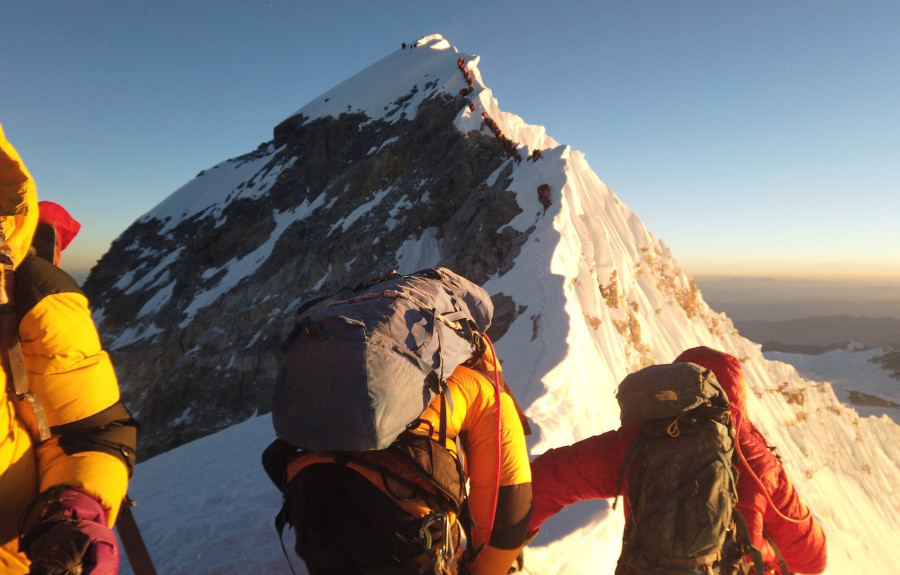National
As climbing season ends, nine deaths on Everest raise questions about overcrowding, but offer few answers
Nepali officials continue to defend their plans to issue permits to a record number of climbers.
Sangam Prasain
On May 29, 1953, for the first time, two men arrived at the highest point on earth. Sixty-six years after Tenzing Norgay and Edmund Hillary summited Mount Everest, this month, nearly 600 climbers followed in their icy footsteps, a feat unprecedented. But not all those who made it to the top came back down. Nine people climbing on the Nepal side died on the mountain, the highest number of deaths in the past four years. Two people died on the Chinese side of the mountain.
Among the dead was 27-year-old Nihal Bagwan from Maharashtra, India. On May 23, a day after a record 200-plus mountaineers ascended Everest, Bagwan and Rahul Inamdar, his teammate, succeeded in reaching the top of the hallowed peak.
“We started early and were the first team to leave from Camp IV,” Inamdar, a 42-year-old engineer, told the Post. “I could see lots of helmet lights following me.”
The Indian team made it to the top safely but when they began to descend, an unusual sight greeted them.
“A snaking line had started to build up and in no time, it became longer and longer,” said Inamdar. “It was a human traffic jam.”
[Read: This is what it takes to get a foreigner to Everest]
A massive queue had formed at the 8,790m Hillary Step and extended to the South Summit (8,690m) and the Balcony (8,400m). There was two-way traffic on the knife ridge that leads to the summit and problems began when each ascending and descending climber had to ‘self anchor’ themselves. Normally, climbers are clipped onto ropes that are tied to anchors set into the rock and ice by Sherpas at the start of the season.
“It was like hold, move, hold. It took us an extra 2 to 3 hours to descend,” said Inamdar. “Almost 21 hours after we left, we came back to Camp IV.”
Inamdar made it back safely but Bagwan was not so lucky. Keshav Poudel, managing director of Peak Promotion, their expedition operator, said that Bagwan became “too weak” and was unable to walk.
“His energy level was almost at zero,” said Poudel. “When his Sherpas started to push him, he would walk for a few minutes and sit down again. Despite difficulties, four Sherpas managed to bring him to Camp IV. He drank water, but breathed his last at 11pm.”
Although the ‘traffic jam’ delayed Bagwan’s descent, it is difficult to say whether it contributed directly to his death, Poudel told the Post.
[Read: In a new record, over 200 climbers summit Everest in a single day]
With the climbing season coming to a close on Tuesday, the nine deaths on Everest, the highest in the last four years, drew concern and criticism from around the world, especially once a photo of a massive queue near the Hillary Step went viral.
On May 22, the longest single-day weather window of 24 hours to summit Everest, had led to 250 climbers vying for the summit. More than 200 made it to the top. This record ascent, however, claimed two climbers— Anjali Kulkarni, 54, from Mumbai and American Donald Lynn Cash, 55. Both of them died from exhaustion caused by the traffic jam, said their expedition organisers.
Kalpana Das, another Indian citizen who reached the summit on May 23, also died while descending the mountain, but her expedition organiser said her death was not due to the traffic jam.
“We have been informed that Sherpa guides asked Das multiple times not to climb further because she was not in a position to walk,” said Meera Acharya, director of the Department of Tourism, the government body that assesses the medical reports of climbers prior to issuing climbing permits. “But she refused and decided to take the risk.”
[Read: The man who made it possible for hundreds of foreigners to climb Everest is finally retiring]

How did the ‘traffic jam’ occur?
May 22’s overcrowding on Everest brought much notoriety to the mountain, but government officials say that the queue developed due to unexpected factors.
According to Acharya, most expedition organisers had planned a summit push on May 20, the second weather window of the season. But the plan fell apart due to strong winds on the summit. That was when the number of climbers began to pile up at Camp IV at 7,900 meters.
This year, the Everest climbing season started on May 14, with a team of eight rope-fixing high-altitude climbers opening up climbing routes. The first two-day weather window closed on May 16 after over 150 climbers made it to the summit. The second climbing window opened on May 20 but strong winds made a summit push impossible.
This season, Everest only saw a six-day climbing window, with the last weather window on May 26. Usually, there are up to 12 climbing windows. Climbers spend two nights at Camp IV and when the summit window opens, they begin their push.
“It’s almost impossible to tell some expedition organisers to stop their climbers while allowing others to go through to the top,” said Acharya. “Everyone starts to make a push.”
This year, expedition organisers were asked to make a timetable for the final push, but the strong winds disrupted that schedule, according to Acharya.
“At 8,000 metres, the government can do nothing,” she said. “Expedition organisers permitted all climbers to go through, which caused the traffic jam. Now, those same operators are blaming the government.”
A ‘traffic jam’ can be especially dangerous above 8,000 metres, considered the ‘Death Zone’. Exhausted climbers are often forced to wait for several hours, awaiting their turn to ascend or descend on a single rope, increasing chances of exhaustion, frostbite or altitude sickness. Climbers could also run out of oxygen during the final phase of the descent.
Acharya said that the government has to plan differently for next year so that a similar traffic jam of this year’s magnitude does not recur. However, she did not outline any specific plans. While veteran mountaineers from around the world have raised concerns about the growing number of Everest permits that Nepal issues every year, Acharya said that the government had no plans to limit permits. And without a limit, the number of climbers is only expected to increase next year.
What else kills people on Everest?
Climbing Everest is an expensive endeavour. Foreigners pay $11,000 for the climbing permit alone but end up spending between $40,000 to $90,000 in total to climb Everest. For many, Everest is the ultimate conquest, a bucket-list item that brings personal satisfaction, prestige and pride.
But as all expenditures are non-refundable, many experienced Sherpa guides say climbers scramble to climb the peak at any cost, which is another contributor to overcrowding on the top of the world.
“People dream of climbing Everest for many years and many spend their life savings on attempting the summit,” said Kami Rita Sherpa, who made headlines this year for climbing Everest twice in a week, bringing his total to a record 24 summits.
“There are many people who want to climb Everest at any cost—even their own lives,” said Kami Rita. “They think of all the money and dreams they’ll lose if they fail.”
In some cases, Sherpa guides are even forced to “slap some sense” into climbers when they belligerently attempt to climb upwards from Camp IV despite being sick or clearly unable to make it to the top, Kami Rita told the Post.
Once you’re up at Camp IV, it is almost impossible for climbers to descend to Base Camp, at 5,500m, and make another attempt the same season, he said.
In 2017, Indian climber Ravi Kumar had forced his guide to push for the summit, even though it was not the appropriate time. He reached the summit but died when descending.
Veteran mountaineer Alan Arnett, in a recent blog post, pointed to several other factors besides overcrowding for the deaths on Everest: inadequate training, inexperience, insufficient oxygen, unclipping from the fixed ropes, health conditions and ‘summit fever’.
But Arnett acknowledged that overcrowding is a primary factor in increasing the risks of death or serious injury.
“It’s clearly true that crowds slow the pace of a climber and thus increase fatigue and the use of oxygen. Some of these climbers who died spent 10 or 12 hours to get to the summit and four to six hours to get back down near the South Col,” he wrote. “In other words, in some cases, a 16, 18 or even 20 hour day.”




 16.35°C Kathmandu
16.35°C Kathmandu








%20(1).jpg&w=300&height=200)






